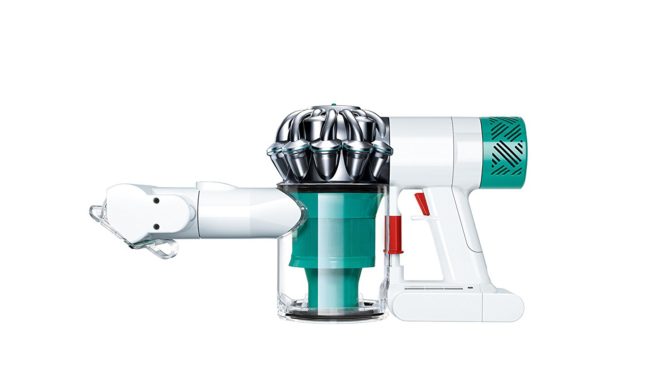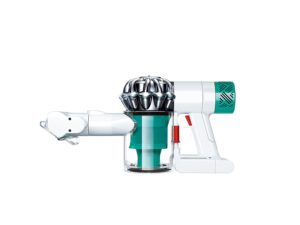
Handheld vacuums, like robotic vacuums, are a compromise. On one hand, you’re never going to get as much power from one as you will from a full-sized upright or canister made within ten years of your cordless vacuum. On the other hand, you’re going to get a level of convenience, if you’re lucky, that you simply can’t achieve from a machine that weighs 10 to 20 pounds (or more!).
Companies like Dyson get that sometimes homeowners want power, which is why they sell uprights like their Ball Animal 2. Sometimes, though, all you want is a machine you can take with you up and down stairs without hauling cords, which is why they sell a range of handheld vacuums that seems to grow every year. We’ve reviewed several so far, with our favorite so far being the Dyson V7 Car+Boat. Today we’re going to review a specialized sibling of the V7, the Dyson V6 Mattress Handheld Vacuum, and see whether it’s worth buying this model over the V7 for allergy management. Our ten second summary is to buy the V7 if you want more battery life and accessories and to buy the V6 if you want HEPA filtration. Our full review is below, and you can buy the V6 Mattress here.
Pros, Cons, and Key Features of the Dyson V6 Mattress Handheld Vacuum
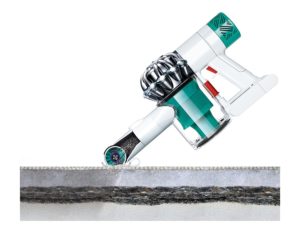
The Dyson V6 Mattress is one of a wide range of handheld vacuums Dyson has released in the last few years. We’re impressed by their dedication but confused by their motivation, as the V6 Car+Boat, Baby+Child, Trigger, Top Dog, and Mattress do more or less the same things. The primary differences between them have to do with accessories; the V7 Car+Boat and Trigger have also entered the fray and add more battery life, but overall, we’re not sure we’re going to be able to keep up with the endless series of cordless clones creeping out of Dyson headquarters.
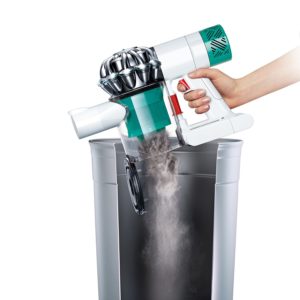
At any rate, the V6 Mattress distinguishes itself from its siblings by being targeted specifically toward families with allergies–or at least a strong interest in reducing dust mites and dead skin cells in their beds. Its key features include a 20 minute battery runtime, a whole machine HEPA filter, four accessories including a motorized mattress tool (which is really just the mini motorized tool on the other V6s and V7s), and the Dyson 2 year warranty. The V6 Mattress weighs 3.5 pounds on our scale, generates up to 100 airwatts in suction, and comes with a .12 gallon dust bin. Its Lithium-ion battery requires 3.5 hours to recharge.
In the box, you’ll find the V6 Mattress and four tools–a motorized mattress tool, which is the tool you’ll end up using the most, a combination tool, a crevice tool, and a mini soft dusting brush. You also get an AC charger.
What’s the difference between the Dyson V6 Mattress and the V7 Car+Boat?
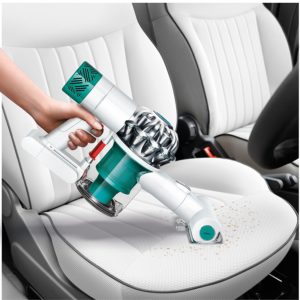
The V6 Mattress is part of the generation preceding the V7 Car+Boat, which means you get some goodies in the V7 generation that weren’t yet available in the V6. The biggest of these is battery life: the V6 has a 20 minute runtime while the V7 gives you 30 minutes, or 50% more vacuuming time. You’ll notice the difference when cleaning, as 30 minutes in our books was just enough to fully clean an SUV, minivan, or a mattress and bedroom from top to bottom. We found 20 minutes on the short side and frequently wished we could have just a bit more power at hand before the battery gave up the ghost. You also get a car charger with the V7 that works anywhere you can find a 12 volt outlet. While you can’t charge and vacuum at the same time, it did let us go back and forth between cleaning manually and using the V7 for a few minutes at a time once the battery charged a bit; we appreciated the convenience here almost as much as we did the extra battery life.
Beyond the V7’s battery and charger upgrades, we also appreciate the larger dust bin it ships with. It’s only slightly larger at .15 gallons vs the Mattress’ .12 gallon tank, but it did make a difference in the amount of grime we were able to squeeze out of our mattresses with the V7 compared to the V6. Keep in mind that the slightly larger tank and significantly better battery life adds up to a bit more weight; the V7 weighs 3.8 pounds while the V6 weighs 3.5. Practically speaking, the difference is negligible when carrying or cleaning with both, but we wanted you to know.
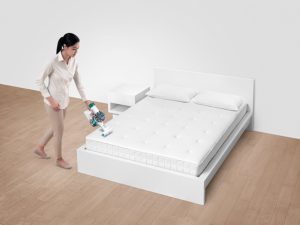
The really interesting difference between both vacuums comes in the accessory comparison. First of all, the V7 comes with more–besides the tools in the V6, you also get an extension hose, which is particularly handy for reaching behind cabinetry and furniture that you just don’t feel like moving, and a stiff bristle brush, which we didn’t use that often but still liked having around. The V7’s accessories come with quick release connectors, which makes them slightly easier to connect and disconnect than those in the V6; we emphasize the slightly because they weren’t that hard to connect and disconnect to begin with in the V6.
However, what we found particularly notable is that the mattress tool in the V6 was functionally identical to the mini motorized tool in the V7; both are powered brushes for extra cleaning. Dyson just renamed it in the Mattress and changed the connector slightly by adding some plastic to it to make it incompatible with the other V6s and V7s without being willing to break off the plastic and potentially invalidate your warranty. Frankly, we found this somewhat disappointing on Dyson’s part.
How useful is the Dyson V6 Mattress when cleaning beds and around the house?
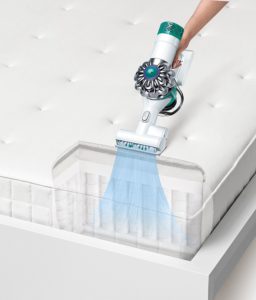
Despite our qualms about Dyson’s rebranding of their mini motorized brush, we were happy with the overall cleaning power of the V6 Mattress. No, it didn’t clean as well as a full-sized upright like the Multi Floor 2, but it was more than powerful enough to attack our mattresses and pull all kinds of unsightly things from them. We also used it freely in other parts of our home, including on counter tops, behind toilets, on stairs, beneath fridges, and to flush out cookie crumbs in car seats.
The 20 minute battery life, while not as long as we’d have liked, was sufficient for many tasks, and with a healthy number of attachments, we felt like we could find one to get most jobs done efficiently. The only tool we really missed, which is exclusive to the Car+Boat, was the extension hose. In our books, every vacuum should come with one; it’s like having really long arms when cleaning, if only temporarily. We did note disappointment in how long it took to recharge the battery; 3.5 hours seemed rather boorish, especially in a world where cheap robotic vacuums like the Shark Robot 750 or Roomba 690 could fully charge themselves in 2-3 hours and deliver hours of runtime. Perhaps we’ll see a change in the V8 or V9, Dyson?
Why buy the Dyson V6 Mattress?
Overall, we found the V6 Mattress to be a powerful and capable vacuum. It has the same amount of suction as any V6 or V7 model at 100 airwatts and packs that suction into a lightweight and easy to carry package. We’re also fans of the 2 year warranty and internal HEPA filter, even though we couldn’t tell if we were actually breathing better after using it or just enjoying a placebo effect. We’d recommend getting the V7 if you’d rather have additional battery life and a few extra accessories, with the extension hose being the most significant piece missing from the V6. That said, if you’re happy with what you get for the V6, we don’t blame you; it’s one of the best handheld vacuums on the market either way.
![]() You can buy the Dyson V6 Mattress here on Amazon. If you want the upgraded features, buy the Dyson V7 Car+Boat vacuum here instead.
You can buy the Dyson V6 Mattress here on Amazon. If you want the upgraded features, buy the Dyson V7 Car+Boat vacuum here instead.
![]() Canadians can buy the Dyson V6 Mattress here on Amazon. If you want more battery life and accessories, buy the V7 Car+Boat vacuum here instead.
Canadians can buy the Dyson V6 Mattress here on Amazon. If you want more battery life and accessories, buy the V7 Car+Boat vacuum here instead.
 If you find our research on PMC helpful, you can follow our efforts to keep maniacally reviewing home cleaning tools by shopping through our links above. We promise to keep fighting the good fight against every horror children, animals, and grown, yet messy humans can inflict upon a clean home.
If you find our research on PMC helpful, you can follow our efforts to keep maniacally reviewing home cleaning tools by shopping through our links above. We promise to keep fighting the good fight against every horror children, animals, and grown, yet messy humans can inflict upon a clean home.

